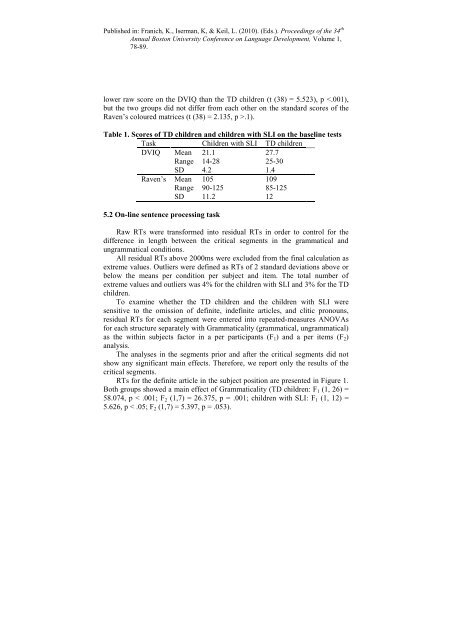On-line Processing of Articles and Clitic Pronouns by Greek ...
On-line Processing of Articles and Clitic Pronouns by Greek ...
On-line Processing of Articles and Clitic Pronouns by Greek ...
You also want an ePaper? Increase the reach of your titles
YUMPU automatically turns print PDFs into web optimized ePapers that Google loves.
Published in: Franich, K., Iserman, K, & Keil, L. (2010). (Eds.). Proceedings <strong>of</strong> the 34 th<br />
Annual Boston University Conference on Language Development, Volume 1,<br />
78-89.<br />
lower raw score on the DVIQ than the TD children (t (38) = 5.523), p .1).<br />
Table 1. Scores <strong>of</strong> TD children <strong>and</strong> children with SLI on the base<strong>line</strong> tests<br />
Task Children with SLI TD children<br />
DVIQ Mean<br />
Range<br />
SD<br />
21.1<br />
14-28<br />
4.2<br />
27.7<br />
25-30<br />
1.4<br />
Raven’s<br />
Mean<br />
Range<br />
SD<br />
105<br />
90-125<br />
11.2<br />
5.2 <strong>On</strong>-<strong>line</strong> sentence processing task<br />
109<br />
85-125<br />
12<br />
Raw RTs were transformed into residual RTs in order to control for the<br />
difference in length between the critical segments in the grammatical <strong>and</strong><br />
ungrammatical conditions.<br />
All residual RTs above 2000ms were excluded from the final calculation as<br />
extreme values. Outliers were defined as RTs <strong>of</strong> 2 st<strong>and</strong>ard deviations above or<br />
below the means per condition per subject <strong>and</strong> item. The total number <strong>of</strong><br />
extreme values <strong>and</strong> outliers was 4% for the children with SLI <strong>and</strong> 3% for the TD<br />
children.<br />
To examine whether the TD children <strong>and</strong> the children with SLI were<br />
sensitive to the omission <strong>of</strong> definite, indefinite articles, <strong>and</strong> clitic pronouns,<br />
residual RTs for each segment were entered into repeated-measures ANOVAs<br />
for each structure separately with Grammaticality (grammatical, ungrammatical)<br />
as the within subjects factor in a per participants (F 1 ) <strong>and</strong> a per items (F 2 )<br />
analysis.<br />
The analyses in the segments prior <strong>and</strong> after the critical segments did not<br />
show any significant main effects. Therefore, we report only the results <strong>of</strong> the<br />
critical segments.<br />
RTs for the definite article in the subject position are presented in Figure 1.<br />
Both groups showed a main effect <strong>of</strong> Grammaticality (TD children: F 1 (1, 26) =<br />
58.074, p < .001; F 2 (1,7) = 26.375, p = .001; children with SLI: F 1 (1, 12) =<br />
5.626, p < .05; F 2 (1,7) = 5.397, p = .053).
















